Package Design Thermal Optimization for Metal-Oxide Gas Sensors by Finite Element Modeling and Infra-Red Imaging Characterization
Abstract
:1. Introduction
2. MOX Gas Sensor: Package Description and Construction
3. 3D Modeling
4. Results of the 3D Simulation
5. Modeling Validation
6. Conclusions
Author Contributions
Funding
Institutional Review Board Statement
Informed Consent Statement
Data Availability Statement
Acknowledgments
Conflicts of Interest
References
- Albrecht, J.D.; Altman, D.H.; Maurer, J.J. Encyclopedia of Thermal Packaging, Set 3: Thermal Packaging Applications, Volume 2: Thermal Management of RF Systems; World Scientific: Singapore, 2018; p. 172. [Google Scholar] [CrossRef]
- Khazaka, R.; Mendizabal, L.; Henry, D.; Hanna, R. Survey of High-Temperature Reliability of Power Electronics Packaging Components. IEEE Trans. Power Electron. 2015, 30, 2456–2464. [Google Scholar] [CrossRef]
- Broughton, J.; Smet, V.; Tummala, R.; Joshi, Y.K. Review of Thermal Packaging Technologies for Automotive Power Electronics for Traction Purposes. J. Electron. Packag. 2018, 140, 040801. [Google Scholar] [CrossRef]
- Cengel, Y.; Ghajar, A. Heat and Mass Transfer: Fundamentals and Applications; Cooling of Electronic Equipment; McGraw Hill: New York, NY, USA, 2020; Chapter 15; p. 992. [Google Scholar]
- Wang, H.; Ma, J.; Tan, S.; Zhang, C.; Tang, H.; Huang, K.; Zhang, Z. Hierarchical dynamic thermal management method for high-performance many-core microprocessors. ACM Trans. Des. Autom. Electron. Syst. (TODAES) 2016, 22, 1–21. [Google Scholar] [CrossRef]
- Salvi, S.S.; Jain, A. A Review of Recent Research on Heat Transfer in Three-Dimensional Integrated Circuits (3-D ICs). IEEE Trans. Compon. Packag. Manuf. Technol. 2021, 11, 802–821. [Google Scholar] [CrossRef]
- Torregiani, C.; Oprins, H.; Vandevelde, B.; Beyne, E.; De Wolf, I. Compact thermal modeling of hot spots in advanced 3D-stacked ICs. In Proceedings of the 11th Electronics Packaging Technology Conference 2009, Singapore, 9–11 December 2009; pp. 131–136. [Google Scholar] [CrossRef]
- Božanić, M.; Sinha, S. Multi-chip Modules and Multi-chip Packaging. In Systems-Level Packaging for Millimeter-Wave Transceivers. Smart Sensors, Measurement and Instrumentation; Springer: Cham, Switzerland, 2019; Volume 34. [Google Scholar] [CrossRef]
- Ghaisas, G.; Krishnan, S. A Critical Review and Perspective on Thermal Management of Power Electronics Modules for Inverters and Converters. Trans. Indian Natl. Acad. Eng. 2022, 7, 47–60. [Google Scholar] [CrossRef]
- Jones-Jackson, S.; Rodriguez, R.; Yang, Y.; Lopera, L.; Emadi, A. Overview of Current Thermal Management of Automotive Power Electronics for Traction Purposes and Future Directions. IEEE Trans. Transp. Electrif. 2022, 8, 2412–2428. [Google Scholar] [CrossRef]
- Lall, P.; Thomas, T.; Suhling, J. Prognostication of Damage in Automotive Underhood Electronics Subjected to Temperature and Vibration. In Proceedings of the 2018 IEEE 68th Electronic Components and Technology Conference (ECTC), San Diego, CA, USA, 29 May–1 June 2018; pp. 1330–1341. [Google Scholar] [CrossRef]
- Chen, Y.; Xie, B.; Long, J.; Kuang, Y.; Chen, X.; Hou, M.; Gao, J.; Zhou, S.; Fan, B.; He, Y.; et al. Interfacial Laser-Induced Graphene Enabling High-Performance Liquid-Solid Triboelectric Nanogenerator. Adv. Mater. 2021, 33, e2104290. [Google Scholar] [CrossRef]
- Fagnard, J.-F.; Stoukatch, S.; Lauren, P.; Dupont, F.; Wolfs, C.; Lambert, S.D.; Redouté, J.-M. Preparation and characterization of a thermal insulating carbon xerogel -epoxy composite adhesive for electronics applications. IEEE Trans. Compon. Packag. Manuf. Technol. 2021, 11, 606–615. [Google Scholar] [CrossRef]
- Liu, Z.; Li, J.; Liu, X. Novel functionalized BN nanosheets/epoxy composites with advanced thermal conductivity and mechanical properties. ACS Appl. Mater. Interfaces 2020, 12, 6503–6515. [Google Scholar] [CrossRef] [PubMed]
- Cadence System Analysis. Available online: https://resources.system-analysis.cadence.com/blog/msa2022-3d-ics-and-the-importance-of-heat-transfer-models (accessed on 7 August 2023).
- Comsol. Analyze Thermal Effects with Advanced Simulation Software. Available online: https://www.comsol.com/heat-transfer-module (accessed on 7 August 2023).
- Ansys, Resource Center. Available online: https://www.ansys.com/resource-center/webinar/thermal-management-for-power-electronics (accessed on 7 August 2023).
- Infineon. Thermal System Modeling. Available online: https://www.infineon.com/dgdl/Thermal+Modeling.pdf?fileId=db3a30431441fb5d011472fd33c70aa3 (accessed on 7 August 2023).
- MathWorks. Available online: https://www.mathworks.com/help/physmod/simscape/thermal-models.html (accessed on 7 August 2023).
- M3d. Available online: http://www.m3dfea.com/ (accessed on 7 August 2023).
- Quickfield. Product, Software Features. Available online: https://quickfield.com/features.htm (accessed on 7 August 2023).
- Rohm. Products, Data Book. Available online: https://fscdn.rohm.com/en/products/databook/applinote/discrete/transistor/what_is_a_thermal_model_tr_an-e.pdf (accessed on 7 August 2023).
- Coppeta, R.; Lahlalia, A.; Kozic, D.; Hammer, R.; Riedler, J.; Toschkoff, G.; Singulani, A.; Ali, Z.; Sagmeister, M.; Carniello, S.; et al. Electro-thermal-mechanical modeling of gas sensor hotplates. In Sensor Systems Simulations: From Concept to Solution; Springer Nature Switzerland AG: Cham, Switzerland, 2020; pp. 17–72. [Google Scholar] [CrossRef]
- Subhash Joshi, T.G.; John, V. Combined transient thermal impedance estimation for pulse-power applications. In Proceedings of the National Power Electronics Conference (NPEC), Pune, India, 18–20 December 2017; pp. 42–47. [Google Scholar] [CrossRef]
- Cauer Thermal Model. Available online: https://www.mathworks.com/help/sps/ref/cauerthermalmodel.html (accessed on 7 August 2023).
- Fluids and Thermal Simulation, Simcenter Flotherm. Available online: https://plm.sw.siemens.com/en-US/simcenter/fluids-thermal-simulation/flotherm/ (accessed on 7 August 2023).
- Dular, P.; Geuzaine, C.; Henrotte, F.; Legros, W. A general environment for the treatment of discrete problems and its application to the finite element method. IEEE Trans. Magn. 1998, 34, 3395–3398. [Google Scholar] [CrossRef]
- Gilleo, K. MEMS/MOEM Packaging: Concepts, Designs, Materials and Processes; McGraw Hill LLC: New York, NY, USA, 2005; p. 220. [Google Scholar] [CrossRef]
- Basyooni, M.; Shaban, M.; El Sayed, A. Enhanced Gas Sensing Properties of Spin-Coated Na-Doped ZnO Nanostructured Films. Sci. Rep. 2017, 7, 41716. [Google Scholar] [CrossRef] [PubMed]
- Rüffer, D.; Hoehne, F.; Bühler, J. New Digital Metal-Oxide (MOX) Sensor Platform. Sensors 2018, 18, 1052. [Google Scholar] [CrossRef] [PubMed]
- Gardner, J.W.; Guha, P.K. CMOS-based resistive and FET devices for smart gas sensors, Editor: E. Llobet. In Micro and Nano Technologies, Advanced Nanomaterials for Inexpensive Gas Microsensors; Elsevier: Amsterdam, The Netherlands, 2020. [Google Scholar] [CrossRef]
- Stoukatch, S.; Fagnard, J.-F.; Roy, G.; Laurent, P.; Dupont, F.; Jacques, P.J.; Redouté, J.-M. Thermal conductivity characterization of an in-house formulated thermal insulating xerogel—Epoxy composite adhesive for electronics applications. In Proceedings of the 2022 IEEE Electronics System-Integration Technology Conference (ESTC), Sibiu, Romania, 13–16 September 2022; pp. 315–320. [Google Scholar] [CrossRef]
- Stoukatch, S.; Fagnard, J.-F.; Laurent, P.; Dupont, F.; Debliquy, M.; Redouté, J.-M. Low Thermal Conductivity Adhesive as a Key Enabler for Compact, Low-Cost Packaging for Metal-Oxide Gas Sensors. IEEE Access 2022, 10, 19242–19253. [Google Scholar] [CrossRef]
- The Engineering Toolbox, Thermal Conductivity. Available online: https://www.engineeringtoolbox.com/thermal-conductivity-d_429.html (accessed on 7 August 2023).
- Pertijs, M.A.P.; Huijsing, J.H. Precision Temperature Sensors in CMOS Technology; Technology & Engineering; Springer: Dordrecht, The Netherlands, 2010; p. 292. [Google Scholar]
- Childs, P.R.N.; Greenwood, J.R.; Long, C.A. Review of temperature measurement. Rev. Sci. Instrum. 2000, 71, 2959–2978. [Google Scholar] [CrossRef]
- Stoukatch, S.; Fagnard, J.-F.; Dupont, F.; Laurent, P.; Redouté, J.-M. Non-contact thermal characterization using IR camera for compact metal-oxide gas sensor. In Proceedings of the 2021 IEEE 23rd Electronics Packaging Technology Conference (EPTC), Singapore, 7–9 December 2021; pp. 483–487. [Google Scholar] [CrossRef]
- OPTOTHERM. Thermal Imaging System, Sentris. Available online: www.optotherm.com/sentris (accessed on 7 August 2023).
- Das, M.; Roy, S. Polypyrrole and associated hybrid nanocomposites as chemiresistive gas sensors: A comprehensive review. Mater. Sci. Semicond. Process. 2021, 121, 105332. [Google Scholar] [CrossRef]
- Das, P.; Maruthapandi, M.; Saravanan, A.; Natan, M.; Jacobi, G.; Banin, E.; Gedanken, A. Carbon dots for heavy-metal sensing, pH-sensitive cargo delivery, and antibacterial applications. ACS Appl. Nano Mater. 2020, 3, 11777–11790. [Google Scholar] [CrossRef]
- Stoukatch, S.; Dupont, F.; Redouté, J.M. Device Processing Challenges for Miniaturized Sensing Systems Targeting Biological Fluids. Biomed. Mater. Devices 2022. [Google Scholar] [CrossRef]
- Das, P.; Ganguly, S.; Mondal, S.; Bose, M.; Das, A.K.; Banerjee, S.; Das, N.C. Heteroatom doped photoluminescent carbon dots for sensitive detection of acetone in human fluids. Sens. Actuators B Chem. 2018, 266, 583–593. [Google Scholar] [CrossRef]

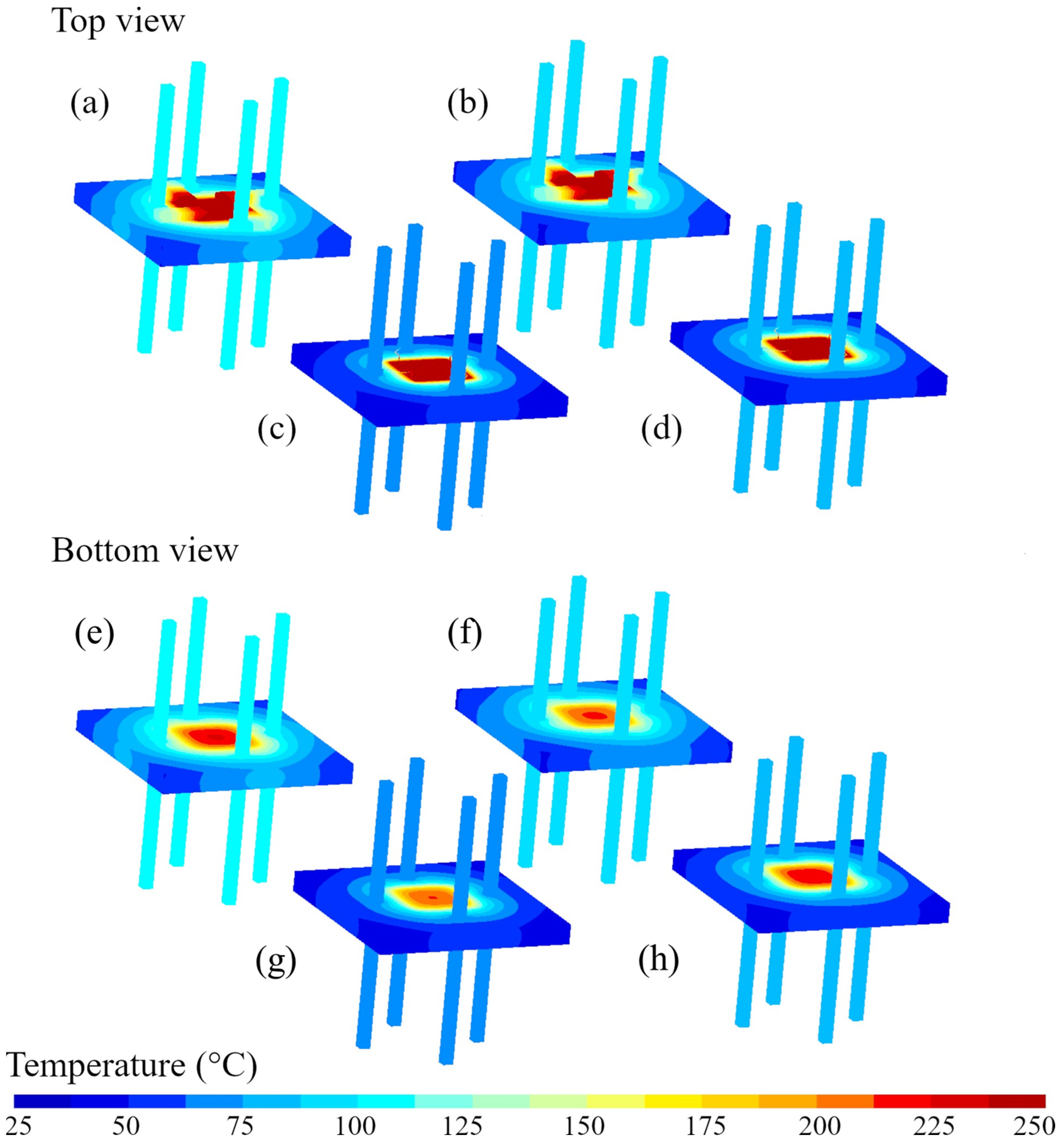
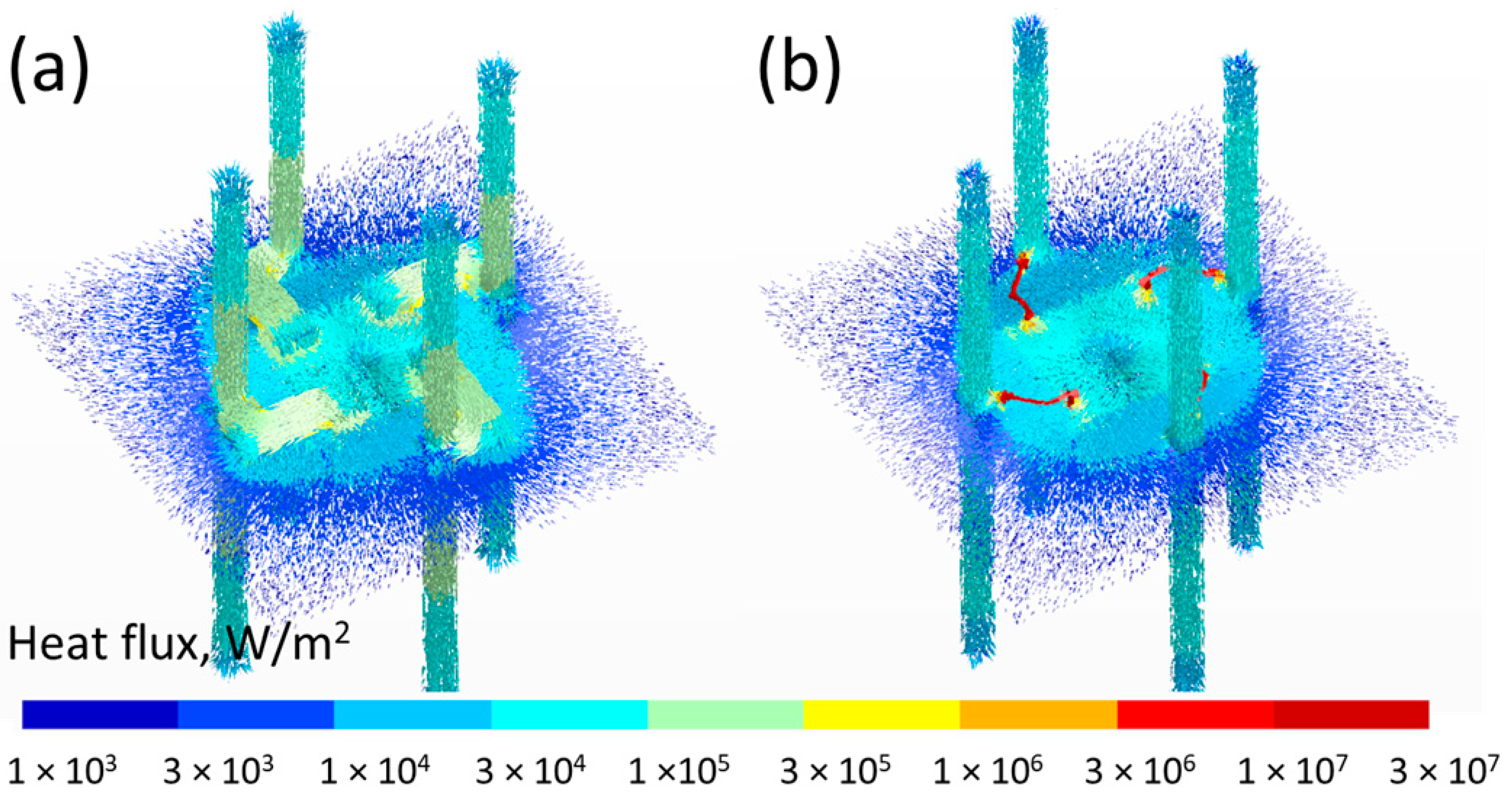
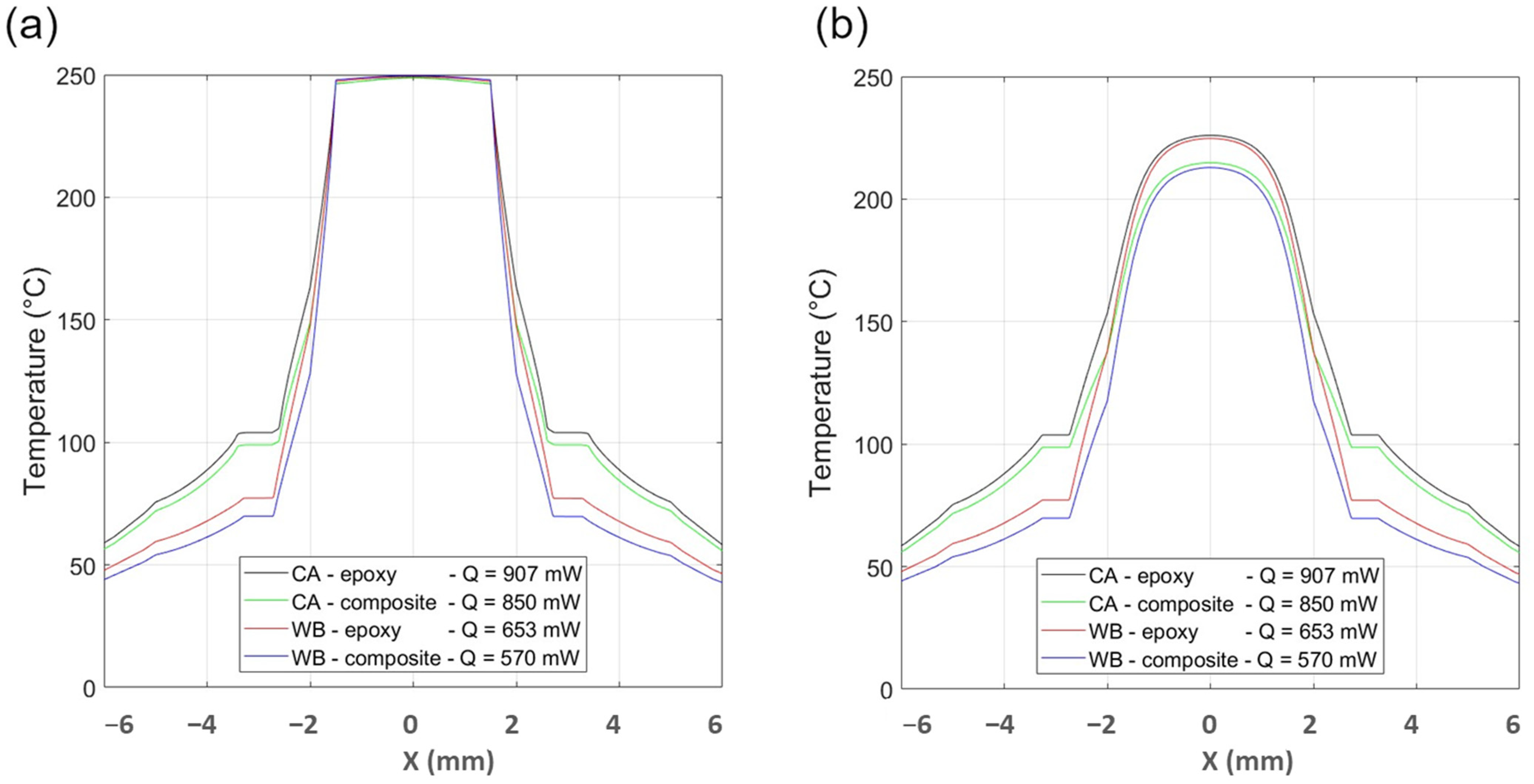
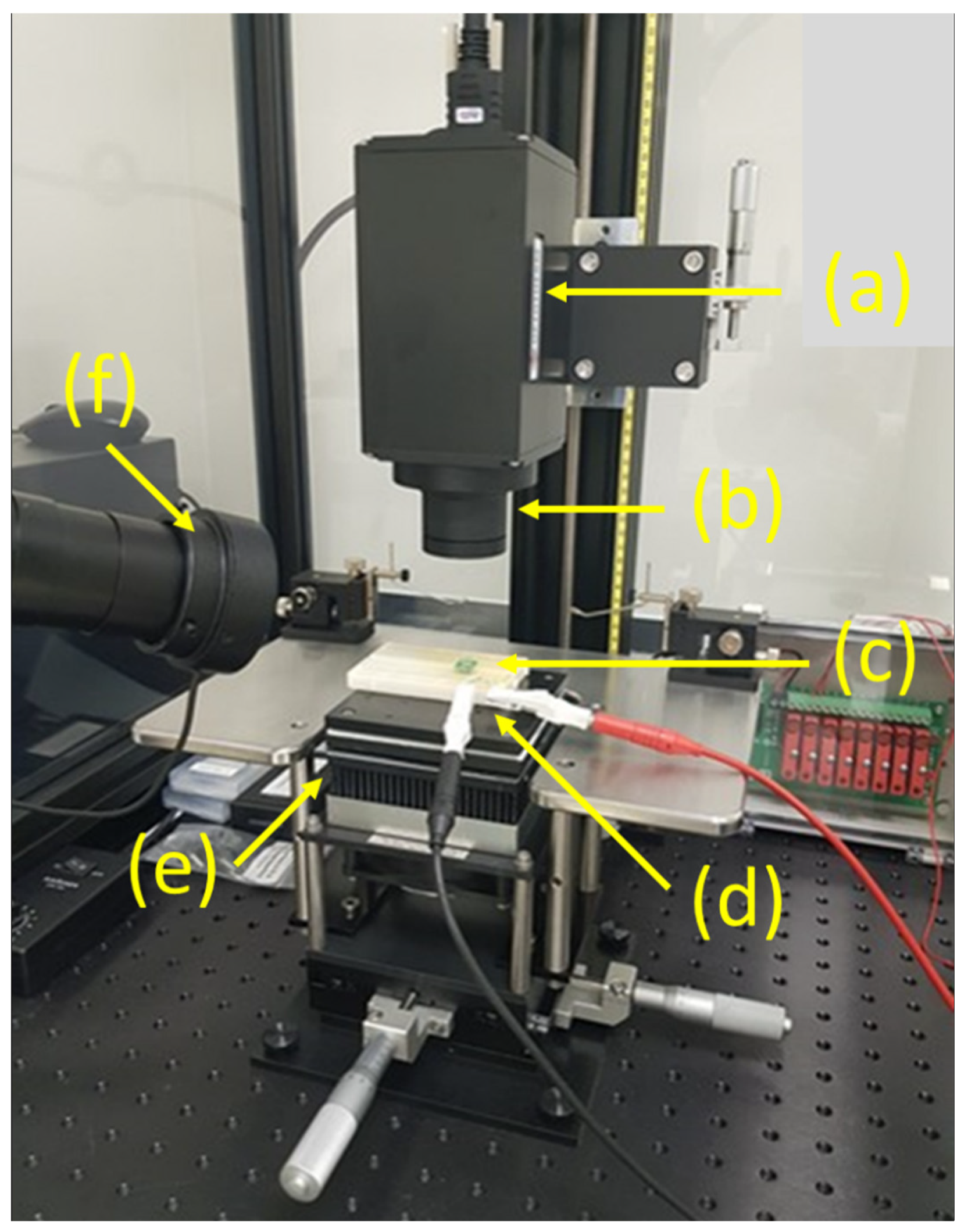
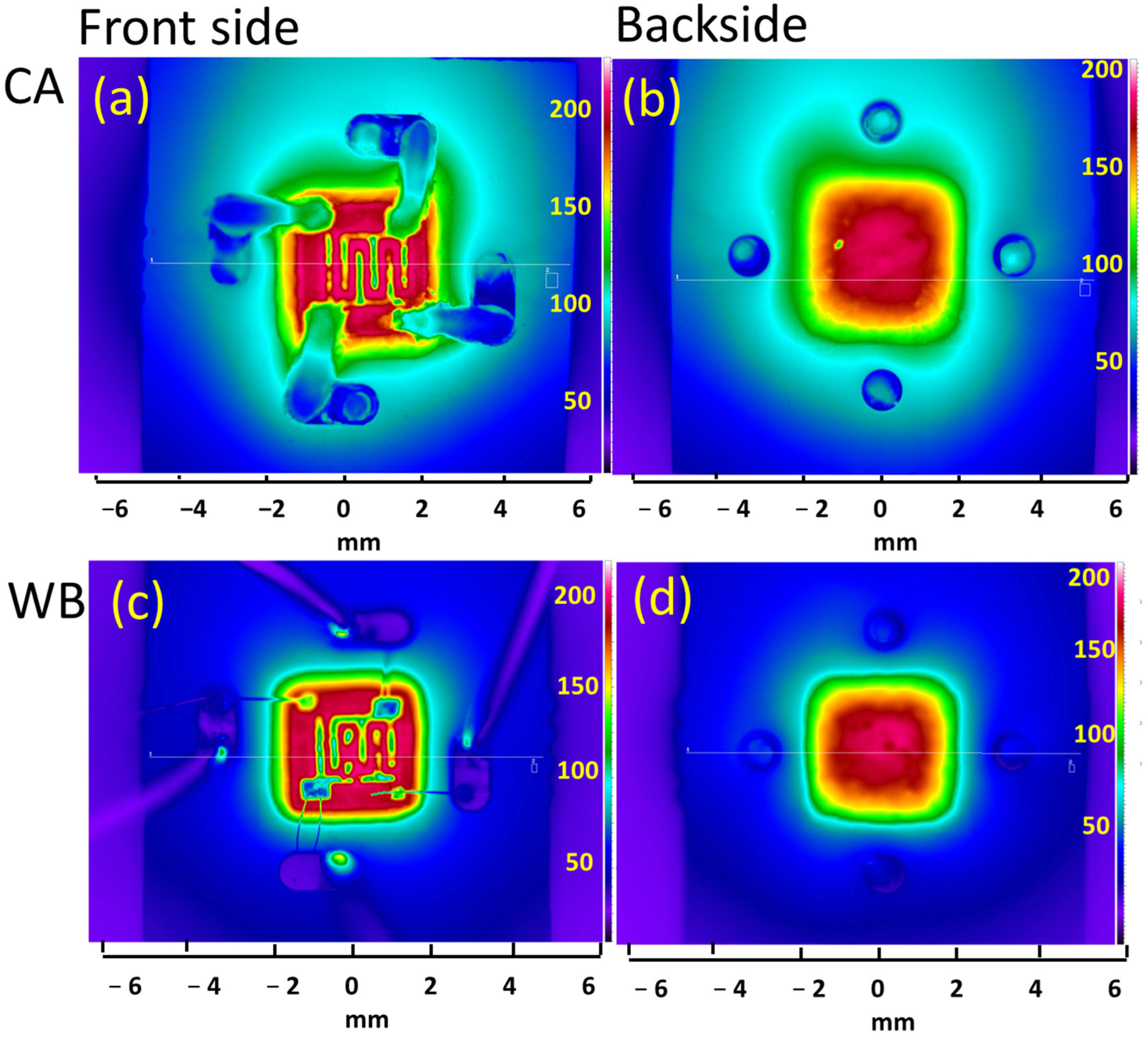
| Material | k (W K−1 m−1) |
|---|---|
| Sensor die (alumina ceramic) | 25 [33] |
| PCB | 0.30 [33] |
| Thermal insulating material (TIM) | |
| xerogel–epoxy composite | 0.108 [32] |
| pure epoxy | 0.168 [32] |
| Interconnection method: | |
| CA tracks: (CA case) | 3.6 [34] |
| Gold wires (WB case) | 317 [34] |
| Copper leads | 380 [34] |
| Air | |
| at 20 °C | 0.0259 [34] |
| at 250 °C | 0.0414 [34] |
| Case | TIM | TIM Tmin/Tmax (°C) | PCB Tmin/Tmax (°C) |
|---|---|---|---|
| CA | pure epoxy | 125/250 | 49/187 |
| CA | xerogel–epoxy | 114/250 | 47/184 |
| WB | pure epoxy | 108/250 | 41/150 |
| WB | xerogel–epoxy | 92/250 | 38/131 |
| Case | TIM Tmin/Tmax (°C) | PCB Tmin/Tmax (°C) | ||
|---|---|---|---|---|
| Modeling | Experimental | Modeling | Experimental | |
| CA | 112/250 | 104/231 | 54/180 | 68/151 |
| WB | 87/250 | 92/222 | 42/117 | 49/115 |
| Case | Q (mW) | |
|---|---|---|
| Modeling | Experimental | |
| CA | 850 | 1180 |
| WB | 570 | 580 |
Disclaimer/Publisher’s Note: The statements, opinions and data contained in all publications are solely those of the individual author(s) and contributor(s) and not of MDPI and/or the editor(s). MDPI and/or the editor(s) disclaim responsibility for any injury to people or property resulting from any ideas, methods, instructions or products referred to in the content. |
© 2023 by the authors. Licensee MDPI, Basel, Switzerland. This article is an open access article distributed under the terms and conditions of the Creative Commons Attribution (CC BY) license (https://creativecommons.org/licenses/by/4.0/).
Share and Cite
Stoukatch, S.; Dupont, F.; Laurent, P.; Redouté, J.-M. Package Design Thermal Optimization for Metal-Oxide Gas Sensors by Finite Element Modeling and Infra-Red Imaging Characterization. Materials 2023, 16, 6202. https://doi.org/10.3390/ma16186202
Stoukatch S, Dupont F, Laurent P, Redouté J-M. Package Design Thermal Optimization for Metal-Oxide Gas Sensors by Finite Element Modeling and Infra-Red Imaging Characterization. Materials. 2023; 16(18):6202. https://doi.org/10.3390/ma16186202
Chicago/Turabian StyleStoukatch, Serguei, Francois Dupont, Philippe Laurent, and Jean-Michel Redouté. 2023. "Package Design Thermal Optimization for Metal-Oxide Gas Sensors by Finite Element Modeling and Infra-Red Imaging Characterization" Materials 16, no. 18: 6202. https://doi.org/10.3390/ma16186202





